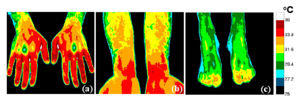Infrared sensing
Infrared viewing encompasses a wide range of technologies that gather information using remote sensing in the infrared portion of the electromagnetic spectrum. Early techniques included "active" or "first generation night viewing", in which the viewer illuminated the area of interst with an infrared light, and viewed the reflections. Later technologies, often in different subparts of the infrared spectrum, passively received and amplified infrared-spectrum heat from the target.
Not all infrared viewing techniques produce a picture, but may produce matrices that assign wavelengths and intensity information to parts of the field being viewed. For example, Defense Support Program and successor satellites, which detect and track missile launchers, are "staring" arrays of infrared detectors that compare successive views. An intense heat pulse in one location shows the launch proper, but the data reduction system compares the heat in successive views to determine the direction and speed of missile travel.
Technologies
Applications
Ground surveillance
Missile launch detection
Medical
Most medical uses are imaging, and are displayed as false-color.
One research program compares multiple imaging methods in the difficult diagnosis of complex regional pain syndromes.[1]
